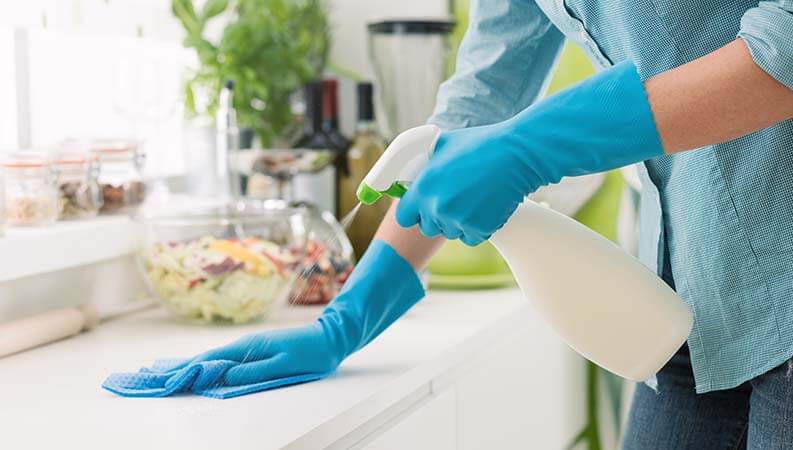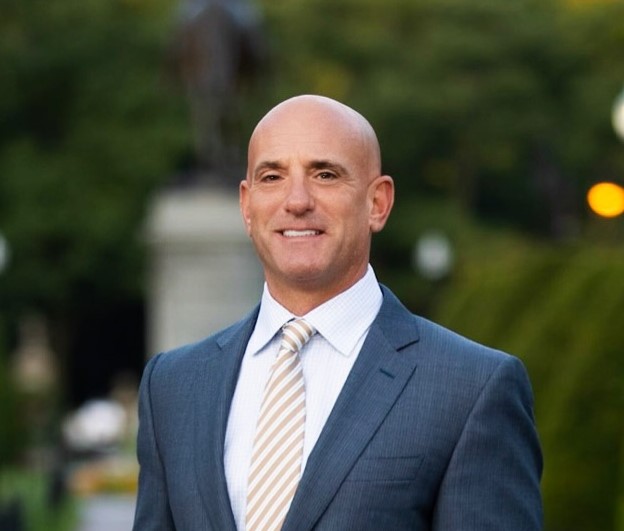
COVID-19 is an official pandemic, but there are steps you can take to keep yourself safe and disinfect your apartment. This is a time for all of us to remain vigilant and increase our levels of awareness. When you leave your apartment, you might be exposed to the COVID-19 virus. Do not succumb to fear! This will not just be counterproductive; it can also be dangerous and make you less safe. Though staying at home and completely away from people would be optimal, it may not be possible for people who need to work and/or shop for food and medicine. Your best lines of defense while you are out are avoiding human contact, not touching your face, and washing your hands.
According to current research, the virus can live on hard surfaces such as stainless steel and plastic for up to 72 hours; it can survive on cardboard for up to 24 hours. Prior research indicates that hard surfaces and flat surfaces are more hospitable to viruses than rough surfaces or cloth. Variables such as light, temperature, and humidity can also determine COVID-19 viability. If sunlight is shining on a surface, the survival rate of the virus may not be as long. The following article will provide instructions on keeping your apartment disinfected to increase your safety.
Clean and Disinfect Flat and Hard Surfaces
When you clean, you remove dirt and some germs from the surface of an object. However, cleaning does not kill germs. To kill germs, you need to use disinfectants. It’s always a good idea to clean surfaces before you disinfect them. Disinfect all areas that are routinely touched such as light switches, desks, toilets, chairs, sinks, doorframes, doorknobs, handles, remotes, keypads, buttons, and counters. Make sure the Environmental Protection Agency has approved the disinfectant for use against SARS-CoV-2 (the virus that causes the COVID-19 coronavirus). Read the instructions and safety precautions before using any chemical. Keep the room well ventilated. As a precaution, use disposable gloves to disinfect and discard them after each use. Wash your hands after you remove the gloves. These gloves should only be used for disinfecting for COVID-19 and should not be used for other cleaning chores.
If it is safe to use on the surface you are cleaning, you can use household bleach. Bleach should never be mixed with any other cleaning product; mix bleach only with water. For each quart of water, you will need 4 teaspoons of bleach or 5 tablespoons per gallon of water. Disinfectant wipes containing bleach are also helpful.
Any type of mold growth needs special consideration. Mold can grow on any surface such as sinks, toys, floors, utensils, stoves, refrigerators, etc. If you need to disinfect an area that is moldy, mix one cup of bleach with one gallon of water. Wash the area well.
Do not use bleach or bleach-based cleaners on soft foam rubber such as yoga mats (they will gradually disintegrate) or on wallpaper (it can discolor the wallpaper). Use non-bleach disinfectants or wipes on these surfaces instead.
Disinfecting Fabrics Against COVID-19
For fabric-covered areas such as couches, carpets, mattresses, and some chairs, you have to follow slightly different procedures. Bleach will damage these materials. Vacuum the surfaces first. This will remove dust, dirt, and other particles that might harbor germs. Next, you will need a spray or aerosol disinfectant to cover the entire area and kill the virus. Use a sweeping motion so that you do not miss any spots. Make sure everything is completely dry before you walk or sit on it.
Disinfect Using Hydrogen Peroxide
You can also use three percent hydrogen peroxide as a disinfectant. Pour the hydrogen peroxide directly on the surface and let is sit for fifteen minutes. Then, scrub and rinse with hot water. Toothbrushes are great places for germs to hide and hydrogen peroxide does a great job of cleaning them also. Peroxide also has a bleaching effect and can discolor some fabrics and finishes.
Cleaning the Places that are Hard to Reach
Dusters with expandable handles are great for sliding under appliances and furniture. Microfiber dusters trap dust and other particles. If you do not have a duster with an expandable handle, you can wrap a cloth around a yardstick or broom. The cloth can be attached with a twist tie or rubber band.
A pillowcase can be helpful for cleaning a ceiling fan. One at a time, place a pillowcase over each blade making sure that both sides are covered. Pull the pillowcase off the blade and it will remove the dust and dirt. Since you are close to the fan, it would be a good idea to cover your nose, mouth, and eyes. If you do not have a safety mask, you can use a scarf or a cotton t-shirt. You can use glasses to protect your eyes.
For cracks, crevices, grooves, and other tight spots where germs may hide, a scrub brush or old toothbrush is helpful. Wipes are generally not effective in these cases because they cannot get into the areas you need to clean. Either spray the surface with an approved disinfectant or dip your brush into the cleaning solution. Then work the bristles into the groove to push in the disinfectant and scrub out any gunk or debris.
Cleaning Places That Are Inaccessible
Windowsills are fairly easy to clean, but the frames that contain the dirt and germs are difficult. The frames leave little room to get your hand inside so you have to have a strategy. Sprinkle baking soda in those hard to reach places; then, squirt in some vinegar. Let it sit for at least ten minutes and then clean out the glop with a toothbrush.
Vents often have tiny slits that seem impossible to clean. They are a convenient place for dust, dirt, and germs to hide. However, with a little imagination, you can make a cleaning tool out of a butter knife, thin spatula, or metal ruler. Dip a paper towel or rag in a cleaning solution and clean.
To do a thorough disinfecting against COVID-19, do not neglect to clean blinds. Blinds are often overlooked because the tops are often not seen. However, they can get very dusty and germy. You can dust one side at a time or both sides at once. Open a pair of kitchen tongs and wrap a cloth on each side. Secure with twist ties or rubber bands. Run the tongs along the slats and both sides will be clean. You can follow dusting with disinfectant spray.
How to Disinfect Personal Electronics
Your cellphone is handled constantly and is probably concealing germs. Make a cleaning mixture of 40% isopropyl alcohol and 60% water. Dampen a lint-free cloth, wipe the cellphone, and let it air dry. Do not drench the cloth as this might damage the cellphone. Do not use a paper towel; that is too abrasive. Disinfectant wipes containing 70% isopropyl alcohol are also safe. Do not use window cleaner, abrasive cleanser, rubbing alcohol, compressed air, dish soap, hand soap, or vinegar. All of these can damage your screen. Remember to clean your case as well!
There are many commercial cleaners on the market for all touch screens and computer monitors, as well as other computer components. If you do not have one of these and you need to clean your keyboard, there is a handy hack. Stand the keyboard up and gently tap it. This will remove loose dirt and debris. Then fold a small sticky note in half and push it between the keys. This will remove any dirt stuck to the keys.
How to Keep Your Apartment Safe When a Resident is Sick
If someone is ill, it is important to provide the proper care for both the patient and other members of the household. When someone first becomes ill, he or she may not know if they have a cold, influenza, or COVID-19. It is very important to keep your apartment clean and disinfected to protect the other residents. The Centers for Disease Control and Prevention recommend the following guidelines.
Ways to Reduce Exposure
If the patient is a responsible adult, provide paper towels, disinfectants, tissues, and cleaners to be left in their bedroom. You should help them clean as seldom as possible to limit your exposure. The sick person should also remain in their bedroom as much as possible.
If members of the household must share a bathroom, the bathroom needs to be cleaned every time the sick person uses it. If the sick person is too weak to clean, you should wait as long as possible before you disinfect the room.
The sick person should eat in their room. Paper plates and plastic utensils would be useful but you should still wear gloves while handling them. Any other dishes and utensils should be washed in the hottest water possible.
Handling Contaminated Items
If possible, wear gloves at all times when handling anything touched by the ill person. If you do not have gloves, follow proper hand washing procedures. Wash hands for twenty seconds with soap and water. A hand sanitizer with 60% alcohol can be substituted if you cannot get to a sink.
The ill person should have his or her own lined trashcan. Wear gloves when emptying the trash and wash your hands immediately. It would also be a good idea to have a separate laundry hamper or bag for the sick person. Use the warmest water possible without damaging the fabrics. When handling contaminated laundry, wear gloves and wash immediately after.
Hand Hygiene to Prevent Virus Spread
Following the suggestions in this article will provide you with the safest means of protecting your apartment from COVID-19. To keep your apartment clean, hand hygiene is imperative. No matter how clean the surfaces are your touch could contaminate them. The most important times to wash or disinfect hands with sanitizer are the following:
- After providing care to a dependent person – diaper changing, hands on care for a dependent adult, etc.
- After using the bathroom
- After contact with animals
- After sneezing, coughing, or blowing your nose
- Before eating
- Before preparing food
- Before providing care to a dependent person
Though there is a great deal of uncertainty surrounding the COVID-19 pandemic, there is also a great deal of research on which to rely. We have ways to create a safe environment in our own apartments. There are also many resources to help you through this difficult time. The Centers for Disease Control and Prevention have a website that will answer many of your questions and concerns. Your local health department will also provide information. If you have concerns about your apartment, remember that Boston Pads is here to help you to stay safe.

Demetrios Salpoglou
Published March 18, 2020
Demetrios has pulled together the largest apartment leasing team in the Greater Boston Area and is responsible for procuring more apartment rentals than anyone in New England – with over 130k people finding their housing through his services. Demetrios is an avid real estate developer, peak performance trainer, educator, guest lecturer and motivational speaker.










